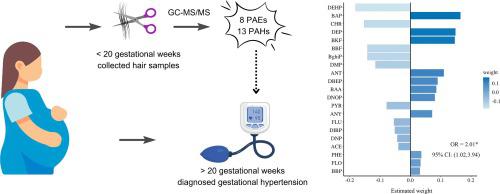当前位置:
X-MOL 学术
›
Environ. Int.
›
论文详情
Our official English website, www.x-mol.net, welcomes your feedback! (Note: you will need to create a separate account there.)
Co-exposure to phthalates and polycyclic aromatic hydrocarbons and the risk of gestational hypertension in Chinese women
Environment International ( IF 11.8 ) Pub Date : 2024-03-06 , DOI: 10.1016/j.envint.2024.108562 Xiaowen Liu , Jigen Na , Xiaojing Liu , Xiaoqian Jia , Mengyuan Ren , Junxi Chen , Bin Han , Jia Xu , Nan Li , Zhiwen Li , Bin Wang
Environment International ( IF 11.8 ) Pub Date : 2024-03-06 , DOI: 10.1016/j.envint.2024.108562 Xiaowen Liu , Jigen Na , Xiaojing Liu , Xiaoqian Jia , Mengyuan Ren , Junxi Chen , Bin Han , Jia Xu , Nan Li , Zhiwen Li , Bin Wang

|
Phthalates (PAEs) and polycyclic aromatic hydrocarbons (PAHs) are frequently detected in females of reproductive age. Many studies have found that environmental PAE and PAH levels are independent risk factors for gestational hypertension. However, exposure to both components is a more realistic scenario. To better assess the health effects of PAEs and PAHs in pregnant women, we explored the associations of exposure to both individual and combined PAEs and PAHs with gestational hypertension. This nested case–control study was a component of a prospective cohort study conducted in Beijing, China. We included 206 women with gestational hypertension and 214 pregnant controls. We used gas chromatography/tandem mass spectrometry (GC–MS/MS) to detect 8 PAEs and 13 PAHs in > 80 % of all collected hair samples. Multiple linear regression models were employed to test the individual associations between each component and gestational hypertension. A quantile-based g-computation (qgcomp) model and a weighted quantile sum (WQS) regression model were used to estimate whether exposure to both PAEs and PAHs increased the risk of gestational hypertension. The individual exposure analyses revealed that diethyl phthalate (DEP), diisobutyl phthalate (DIBP) (both PAEs), benzo(k)fluoranthene (BKF), anthracene, (ANT), and benzo(a)pyrene (BAP) (all PAHs) were positively associated with increased risk of gestational hypertension. In mixed-effect analyses, the qgcomp model indicated that co-exposure to PAEs and PAHs increased the risk of gestational hypertension (odds ratio = 2.01; 95 % confidence interval: 1.02, 3.94); this finding was verified by the WQS regression model. Our findings support earlier evidence that both PAEs and PAHs increase the risk of gestational hypertension, both individually and in combination. This suggests that reductions in exposure to endocrine system-disrupting chemicals such as PAEs and PAHs might reduce the risk of gestational hypertension.
中文翻译:

中国女性同时接触邻苯二甲酸盐和多环芳烃与妊娠期高血压风险
育龄女性中经常检测到邻苯二甲酸盐 (PAE) 和多环芳烃 (PAH)。许多研究发现环境PAE和PAH水平是妊娠期高血压的独立危险因素。然而,接触这两种成分是更现实的情况。为了更好地评估 PAE 和 PAH 对孕妇的健康影响,我们探讨了单独和组合 PAE 和 PAH 的暴露与妊娠期高血压的关系。这项巢式病例对照研究是在中国北京进行的前瞻性队列研究的一部分。我们纳入了 206 名患有妊娠高血压的女性和 214 名怀孕对照者。我们使用气相色谱/串联质谱 (GC-MS/MS) 检测了 80% 以上收集的头发样本中的 8 种 PAE 和 13 种 PAH。采用多元线性回归模型来测试每个成分与妊娠高血压之间的个体关联。基于分位数的 g 计算 (qgcomp) 模型和加权分位数总和 (WQS) 回归模型用于估计接触 PAE 和 PAH 是否会增加妊娠期高血压的风险。单独暴露分析显示,邻苯二甲酸二乙酯 (DEP)、邻苯二甲酸二异丁酯 (DIBP)(均为 PAE)、苯并 (k) 荧蒽 (BKF)、蒽 (ANT) 和苯并 (a) 芘 (BAP)(均为 PAH)与妊娠期高血压风险增加呈正相关。在混合效应分析中,qgcomp 模型表明,同时接触 PAE 和 PAH 会增加妊娠期高血压的风险(比值比 = 2.01;95% 置信区间:1.02、3.94);这一发现得到了WQS回归模型的验证。我们的研究结果支持了早期的证据,即 PAE 和 PAH 单独或组合都会增加妊娠高血压的风险。这表明,减少接触干扰内分泌系统的化学物质(例如 PAE 和 PAH)可能会降低妊娠期高血压的风险。
更新日期:2024-03-06
中文翻译:

中国女性同时接触邻苯二甲酸盐和多环芳烃与妊娠期高血压风险
育龄女性中经常检测到邻苯二甲酸盐 (PAE) 和多环芳烃 (PAH)。许多研究发现环境PAE和PAH水平是妊娠期高血压的独立危险因素。然而,接触这两种成分是更现实的情况。为了更好地评估 PAE 和 PAH 对孕妇的健康影响,我们探讨了单独和组合 PAE 和 PAH 的暴露与妊娠期高血压的关系。这项巢式病例对照研究是在中国北京进行的前瞻性队列研究的一部分。我们纳入了 206 名患有妊娠高血压的女性和 214 名怀孕对照者。我们使用气相色谱/串联质谱 (GC-MS/MS) 检测了 80% 以上收集的头发样本中的 8 种 PAE 和 13 种 PAH。采用多元线性回归模型来测试每个成分与妊娠高血压之间的个体关联。基于分位数的 g 计算 (qgcomp) 模型和加权分位数总和 (WQS) 回归模型用于估计接触 PAE 和 PAH 是否会增加妊娠期高血压的风险。单独暴露分析显示,邻苯二甲酸二乙酯 (DEP)、邻苯二甲酸二异丁酯 (DIBP)(均为 PAE)、苯并 (k) 荧蒽 (BKF)、蒽 (ANT) 和苯并 (a) 芘 (BAP)(均为 PAH)与妊娠期高血压风险增加呈正相关。在混合效应分析中,qgcomp 模型表明,同时接触 PAE 和 PAH 会增加妊娠期高血压的风险(比值比 = 2.01;95% 置信区间:1.02、3.94);这一发现得到了WQS回归模型的验证。我们的研究结果支持了早期的证据,即 PAE 和 PAH 单独或组合都会增加妊娠高血压的风险。这表明,减少接触干扰内分泌系统的化学物质(例如 PAE 和 PAH)可能会降低妊娠期高血压的风险。



























 京公网安备 11010802027423号
京公网安备 11010802027423号